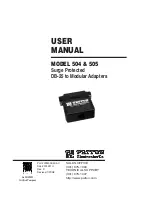
9
4.4. Serial Configuration
An ASCII terminal or PC with a terminal emulation is connected to the first serial port of
the EAD 02. The terminal (or PC) should be configured for 9600 Baud, no parity, 8-bit,
and 1 or 2 stop bits. To enter configuration mode, the power on the EAD 02 must be
cycled (powered off and back on). After power-up, the self-test begins. About a half
second later the red LED starts blinking. Now three lowercase ‘x’ characters must be sent
to the EAD 02. These characters must all be sent within approximately one second to
start configuration mode.
NOTE:
The easiest way to enter the configuration is to hold down the ‘x’ key at the
terminal (emulation) and then powering the EAD 02. This will ensure that the x
characters will arrive in time.
4.5. Configuration Parameters
After configuration mode is entered (confirm with <CR>), the parameters can be
changed; default values can be confirmed with the enter key. The parameters must be
stored, and the EAD 02 performs a reset.
4.6. Basic Parameters
To change the basic Server parameters, press ‘0’. The following values can be
set/changed:
4.6.1. IP Address
The IP address must be set to a unique value in your network. Please refer to the literature
mentioned in Appendix B if you are not familiar with IP addresses. If the EAD 02 is set
to an address already in use, it will display an error code with the LEDs and it will not
connect to the network.
4.6.2. Gateway IP Address
The router/gateway address is needed to communicate to other LAN segments. The
default gateway must be set to address the router that connects these segments. This
address must be within the local network. If in doubt, consult the network administrator.
4.6.3. Netmask
A netmask defines how many bits from the IP address are to be taken as the network
section and how many bits are to be taken as the host section (reminder: Standard class A
8/24 (net/host), class B 16/16, class C 24/8 bits). If set to 0, the standard appropriate










































